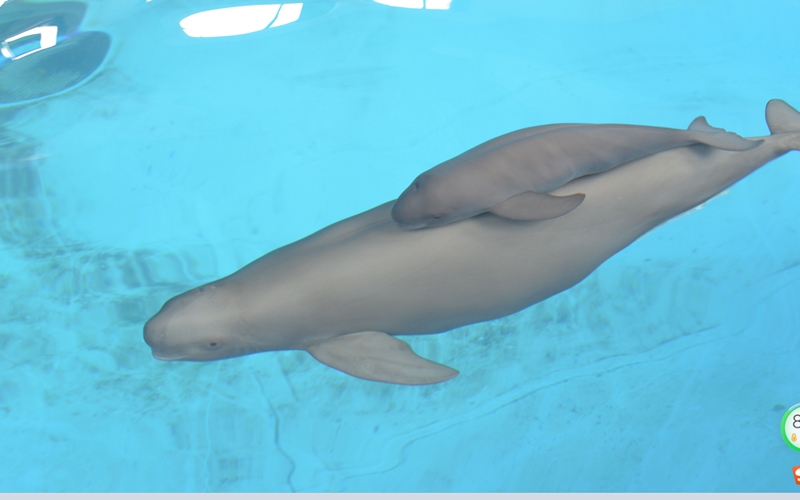Millions of netizens witness precious birth of baby Yangtze finless porpoise in central China's Hubei
On the evening of July 6, the Institute of Hydrobiology (IHB) at the Chinese Academy of Sciences in Wuhan, central China’s Hubei Province, released videos showing a Yangtze finless porpoise giving birth to a baby, which marked a new achievement in the artificial breeding and reproduction of the species.
Yangtze finless porpoise “Fujiu” swims about in the water at the Yangtze River Dolphin Aquarium operated under the Institute of Hydrobiology (IHB) of the Chinese Academy of Sciences in Wuhan, central China’s Hubei Province. (Photo courtesy of Wuhan Baiji Conservation Foundation)
According to the clips released to the public, a Yangtze finless porpoise nicknamed “Fujiu” gave birth to a baby numbered “F9C22” at about 9:35 p.m. on June 27. Altogether, more than three million people watched the videos.
This was the second time that Fujiu, now 14 years old, gave birth to a baby after her first delivery on Sept. 21, 2019 at the Yangtze River Dolphin Aquarium operated by the IHB. So far, both Fujiu and her baby remain in good health.
Fujiu was transferred from Poyang Lake in east China’s Jiangxi Province to Wuhan in 2011 thanks to ongoing ex-situ conservation efforts.

File photo shows a Yangtze finless porpoise and her baby. (Photo courtesy of Wuhan Baiji Conservation Foundation)
In August 2021, researchers from the IHB discovered that Fujiu was more than one month pregnant after conducting a physical examination.
Hao Yujiang, an associate researcher with the institute, explained that researchers then made appropriate preparations to look after Fujiu properly over the course of her pregnancy by ensuring excellent water quality while maintaining a constant temperature below 28 degrees Celsius and a quiet environment, in addition to meeting all of the nutritional requirements for Fujiu during her gestation period.
The Yangtze finless porpoise is categorized as a national first-class protected animal in China. According to a survey conducted in 2017, altogether there were about 1,012 Yangtze finless porpoises tallied at that time. The marine animal’s females have a gestation period of 12 months and usually give birth to one baby at a time.
Yangtze finless porpoise “Fujiu” (L) swims about in the water at the Yangtze River Dolphin Aquarium located in Wuhan, central China’s Hubei Province. (Photo courtesy of Wuhan Baiji Conservation Foundation)
Over the past years, the IHB has worked together with various research and protection institutes and has achieved significant progress in porpoise artificial breeding and reproduction.
In addition to F9C22, there are six other Yangtze finless porpoises currently being kept in captivity, three of which were bred through artificial breeding programs.
“The theoretical knowledge and basic techniques accumulated from the artificial breeding and reproduction of Yangtze finless porpoise are vital to the in-situ and ex-situ conservation of the species,” said Wang Kexiong, a leading researcher at the IHB.

An aquarist plays with a Yangtze finless porpoise. (Photo courtesy of Wuhan Baiji Conservation Foundation)
Photos
Related Stories
Copyright © 2022 People's Daily Online. All Rights Reserved.









